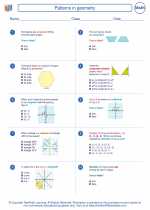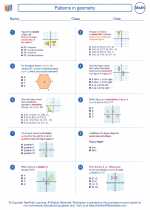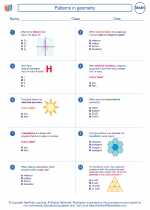Patterns in Geometry
Introduction
In geometry, patterns can be found in the arrangement of shapes, angles, and lines. Recognizing and understanding these patterns is important for solving geometric problems and understanding the relationships between different geometric elements.
Types of Patterns in Geometry
There are several types of patterns that can be observed in geometry:
- Repetition of Shapes: Patterns can be seen in the repetition of specific shapes within a geometric figure or design.
- Symmetry: Symmetrical patterns occur when a shape or design can be divided into two equal parts that are mirror images of each other.
- Geometric Progressions: Patterns can also be found in the progression of geometric elements such as angles, side lengths, or areas.
- Tesselations: Tesselations are patterns formed by repeating a shape or group of shapes to fill a plane without any gaps or overlaps.
Examples of Patterns in Geometry
Here are some examples of patterns in geometry:
- Regular Polygons: The interior angles of regular polygons form a pattern based on the number of sides.
- Fractals: Fractals exhibit self-similar patterns at different scales, making them a unique geometric pattern.
- Geometric Transformations: Patterns can be observed when applying transformations such as translations, rotations, and reflections to geometric shapes.
Study Guide
To understand patterns in geometry, students should focus on the following key concepts:
- Identifying and analyzing patterns in the arrangement of shapes, angles, and lines.
- Understanding the properties of symmetrical figures and recognizing different types of symmetry such as reflection, rotational, and translational symmetry.
- Exploring tesselations and recognizing how different shapes can be combined to create patterns without any gaps or overlaps.
- Applying geometric progressions to understand how certain geometric elements change or progress in a pattern.
By mastering these concepts, students will be able to recognize and analyze patterns in various geometric contexts, leading to a deeper understanding of geometry as a whole.
. Create and Print your own Math Worksheetswith Math Worksheet Generator
◂Math Worksheets and Study Guides Eighth Grade. Patterns in geometry
Study Guide Patterns in geometry
Patterns in geometry  Worksheet/Answer key
Worksheet/Answer key Patterns in geometry
Patterns in geometry  Worksheet/Answer key
Worksheet/Answer key Patterns in geometry
Patterns in geometry  Worksheet/Answer key
Worksheet/Answer key Patterns in geometry
Patterns in geometry 

 Worksheet/Answer key
Worksheet/Answer key
 Worksheet/Answer key
Worksheet/Answer key
 Worksheet/Answer key
Worksheet/Answer key

The resources above cover the following skills:
Geometry (NCTM)
Analyze characteristics and properties of two- and three-dimensional geometric shapes and develop mathematical arguments about geometric relationships.
Create and critique inductive and deductive arguments concerning geometric ideas and relationships, such as congruence, similarity, and the Pythagorean relationship.
Apply transformations and use symmetry to analyze mathematical situations.
Describe sizes, positions, and orientations of shapes under informal transformations such as flips, turns, slides, and scaling.
Examine the congruence, similarity, and line or rotational symmetry of objects using transformations.